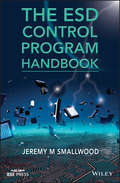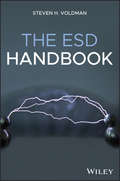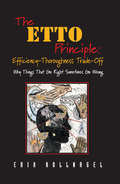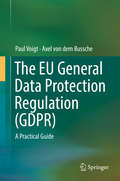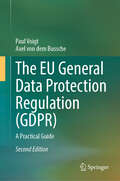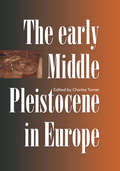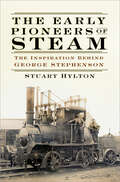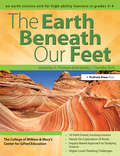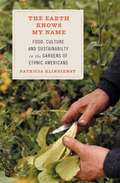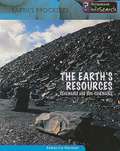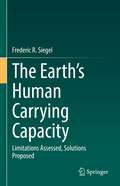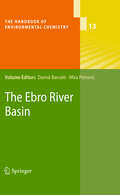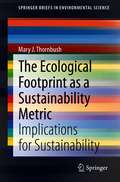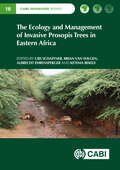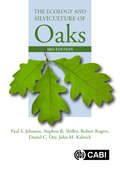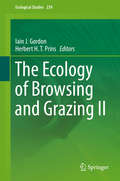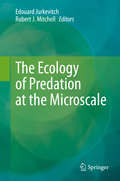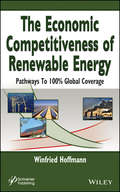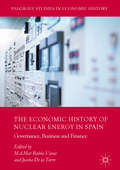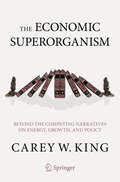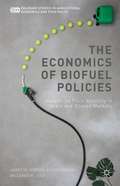- Table View
- List View
The ESD Control Program Handbook (Wiley - IEEE)
by Jeremy M. SmallwoodProvides the understanding and practical skills needed to develop and maintain an effective ESD control program for manufacturing, storage, and handling of ESD sensitive components This essential guide to ESD control programs explains the principles and practice of ESD control in an easily accessible way whilst also providing more depth and a wealth of references for those who want to gain a deeper knowledge of the subject. It describes static electricity and ESD principles such as triboelectrification, electrostatic fields, and induced voltages, with the minimum of theory or mathematics. It is designed for the reader to "dip into" as required, rather than need to read cover to cover. The ESD Control Program Handbook begins with definitions and commonly used terminology, followed by the principles of static electricity and ESD control. Chapter 3 discusses ESD susceptible electronic devices, and how ESD susceptibility of a component is measured. This is followed by the “Seven habits of a highly effective ESD program”, explaining the essential activities of an effective ESD control program. While most texts mainly address manual handling of ESD susceptible devices, Chapter 5 extends the discussion to ESD control in automated systems, processes and handling, which form a major part of modern electronic manufacture. Chapter 6 deals with requirements for compliance given by the IEC 61340-5-1 and ANSI/ESD S20.20 ESD control standards. Chapter 7 gives an overview of the selection, use, care and maintenance of equipment and furniture commonly used to control ESD risks. The chapter explains how these often work together as part of a system and must be specified with that in mind. ESD protective packaging is available in an extraordinary range of forms from bags, boxes and bubble wrap to tape and reel packaging for automated processes. The principles and practice of this widely misunderstood area of ESD control are introduced in Chapter 8. The thorny question of how to evaluate an ESD control program is addressed in Chapter 9 with a goal of compliance with a standard as well as effective control of ESD risks and possible customer perceptions. Whilst evaluating an existing ESD control program provides challenges, developing an ESD control program from scratch provides others. Chapter 10 gives an approach to this. Standard test methods used in compliance with ESD control standards are explained and simple test procedures given in Chapter 11. ESD Training has long been recognised as essential in maintaining effective ESD control. Chapter 12 discusses ways of covering essential topics and how to demonstrate static electricity in action. The book ends with a look at where ESD control may go in the near future. The ESD Control Program Handbook: Gives readers a sound understanding of the subject to analyze the ESD control requirements of manufacturing processes, and develop an effective ESD control program Provides practical knowledge, as well as sufficient theory and background to understand the principles of ESD control Teaches how to track and identify how ESD risks arise, and how to identify fitting means for minimizing or eliminating them Emphasizes working with modern ESD control program standards IEC 61340-5-1 and ESD S20:20 The ESD Control Program Handbook is an invaluable reference for anyone tasked with setting up, evaluating, or maintaining an effective ESD control program, training personnel, or making ESD control related measurements. It would form an excellent basis for a University course on the subject as well as a guide and resource for industry professionals.
The ESD Handbook
by Steven H. VoldmanA practical and comprehensive reference that explores Electrostatic Discharge (ESD) in semiconductor components and electronic systems The ESD Handbook offers a comprehensive reference that explores topics relevant to ESD design in semiconductor components and explores ESD in various systems. Electrostatic discharge is a common problem in the semiconductor environment and this reference fills a gap in the literature by discussing ESD protection. Written by a noted expert on the topic, the text offers a topic-by-topic reference that includes illustrative figures, discussions, and drawings. The handbook covers a wide-range of topics including ESD in manufacturing (garments, wrist straps, and shoes); ESD Testing; ESD device physics; ESD semiconductor process effects; ESD failure mechanisms; ESD circuits in different technologies (CMOS, Bipolar, etc.); ESD circuit types (Pin, Power, Pin-to-Pin, etc.); and much more. In addition, the text includes a glossary, index, tables, illustrations, and a variety of case studies. Contains a well-organized reference that provides a quick review on a range of ESD topics Fills the gap in the current literature by providing information from purely scientific and physical aspects to practical applications Offers information in clear and accessible terms Written by the accomplished author of the popular ESD book series Written for technicians, operators, engineers, circuit designers, and failure analysis engineers, The ESD Handbook contains an accessible reference to ESD design and ESD systems.
The ETTO Principle: Why Things That Go Right Sometimes Go Wrong
by Erik HollnagelAccident investigation and risk assessment have for decades focused on the human factor, particularly 'human error'. Countless books and papers have been written about how to identify, classify, eliminate, prevent and compensate for it. This bias towards the study of performance failures, leads to a neglect of normal or 'error-free' performance and the assumption that as failures and successes have different origins there is little to be gained from studying them together. Erik Hollnagel believes this assumption is false and that safety cannot be attained only by eliminating risks and failures. The ETTO Principle looks at the common trait of people at work to adjust what they do to match the conditions - to what has happened, to what happens, and to what may happen. It proposes that this efficiency-thoroughness trade-off (ETTO) - usually sacrificing thoroughness for efficiency - is normal. While in some cases the adjustments may lead to adverse outcomes, these are due to the very same processes that produce successes, rather than to errors and malfunctions. The ETTO Principle removes the need for specialised theories and models of failure and 'human error' and offers a viable basis for effective and just approaches to both reactive and proactive safety management.
The EU General Data Protection Regulation (GDPR)
by Paul Voigt Axel von dem BusscheThis book provides expert advice on the practical implementation of the European Union’s General Data Protection Regulation (GDPR) and systematically analyses its various provisions. Examples, tables, a checklist etc. showcase the practical consequences of the new legislation. The handbook examines the GDPR’s scope of application, the organizational and material requirements for data protection, the rights of data subjects, the role of the Supervisory Authorities, enforcement and fines under the GDPR, and national particularities. In addition, it supplies a brief outlook on the legal consequences for seminal data processing areas, such as Cloud Computing, Big Data and the Internet of Things.Adopted in 2016, the General Data Protection Regulation will come into force in May 2018. It provides for numerous new and intensified data protection obligations, as well as a significant increase in fines (up to 20 million euros). As a result, not only companies located within the European Union will have to change their approach to data security; due to the GDPR’s broad, transnational scope of application, it will affect numerous companies worldwide.
The EU General Data Protection Regulation (GDPR): A Practical Guide
by Paul Voigt Axel von dem BusscheSix years have passed since the General Data Protection Regulation (GDPR) entered into force. With its numerous data protection obligations and the threat of high fines, companies had to change their approach to data protection. It has been an ongoing challenge for companies to keep up with the constant changes deriving from a plethora of new decisions by courts and supervisory authorities. The 2nd Edition of this book provides a practical overview of the requirements of the GDPR. Examples, tables, and checklists showcase the requirements of the GDPR, whilst also giving practical tips to tackle the regulatory challenges. The handbook examines the GDPR’s scope of application, the organisational and material requirements of the GDPR, the rights of data subjects, the role of the supervisory authorities, and enforcement and fines. The book has been completely revised for the second edition and takes extensive account of new data protection case law and regulatory guidelines.
The Early Middle Pleistocene in Europe
by Charles TurnerThese papers show how new research in the classic areas and Germany, but particularly in Eastern Europe, is radically altering views of the stratigraphy and palaeocology of the early-middle Pleistocene period, showing that major glaciations did not begin only in the late- middle Pleistocene.
The Early Pioneers of Steam: The Inspiration Behind George Stephenson
by Stuart HyltonWe think of the Stephensons and Brunel as the fathers of the railways, and their Liverpool and Manchester and Great Western Railways as the prototypes of the modern systems. But who were the railways’ grandfathers and great-grandfathers? The rapid evolution of the railways after 1830 depended on the juggernauts of steam locomotion being able to draw upon centuries of experience in using and developing railways, and of harnessing the power of steam. Giants the Stephensons and others may have been, but they stood upon the foundations built by many other considerable – if lesser-known – talents. This is the story of those early pioneers of steam.
The Early Poetry of Robert Graves: The Goddess Beckons
by Kersnowski Frank L.Like many men of his generation, poet Robert Graves was indelibly marked by his experience of trench warfare in World War I. The horrific battles in which he fought and his guilt over surviving when so many perished left Graves shell-shocked and disoriented, desperately seeking a way to bridge the rupture between his conventional upbringing and the uncertainties of postwar British society. In this study of Graves's early poetry, Frank Kersnowski explores how his war neurosis opened a door into the unconscious for Graves and led him to reject the essential components of the Western idea of reality—reason and predictability. In particular, Kersnowski traces the emergence in Graves's early poems of a figure he later called "The White Goddess," a being at once terrifying and glorious, who sustains life and inspires poetry. Drawing on interviews with Graves's family, as well as unpublished correspondence and drafts of poems, Kersnowski argues that Graves actually experienced the White Goddess as a real being and that his life as a poet was driven by the purpose of celebrating and explaining this deity and her matriarchy.
The Earth Beneath Our Feet: An Earth Science Unit for High-Ability Learners in Grades 3-4
by Clg Of William And Mary/Ctr Gift EdChildren are fascinated by rocks. They enjoy digging in the ground and take pleasure in finding rocks of various types. The Earth Beneath Our Feet, an Earth science unit for high-ability third and fourth graders, builds on the excitement that students have by engaging them in hands-on scientific investigations about rocks. Students begin to explore and understand the major components of rocks, the rock cycle, and the important uses of rocks. The unit works to expand the students' content knowledge by including information about weathering and the impact that various natural and man-made processes have on the ground they walk on.Grades 3-4
The Earth Knows My Name: Food, Culture, And Sustainability In The Gardens Of Ethnic Americans
by Patricia KlindienstInspired by her own family's immigrant history, Patricia Klindienst traveled the country, gathering stories of urban, suburban, and rural gardens created by people rarely presented in books about American gardens: Native Americans, immigrants from across Asia and Europe, and ethnic peoples who were here long before our national boundaries were drawn. In The Earth Knows My Name, she writes about the beautiful gardens she discovered, each one an island of hope, offering us a model-on a sustainable scale-of a truly restorative ecology. "A moving tribute to those who keep the ancient love of the land in their hearts, and who stand up to the giants of agrobusiness in their fight to preserve their cultural heritage." -Dr. Jane Goodall, DBE, founder of the Jane Goodall Institute, UN Messenger of Peace, and author of Harvest for Hope: A Guide to Mindful Eating "Carefully weaving the threads of the cultures that were here before with those that came later, Klindienst makes her case for the deep, life-giving integrity of the earth . . . This is a poignant book that shows, without undue sentimentality, the underlying element we all share and can bring to life with our hands." -Edie Clark, Orion Patricia Klindienst is a master gardener and an award-winning scholar and teacher. She lives in Guilford, Connecticut, and teaches creative writing each summer at Yale University.
The Earth's Resources: Renewable and Non-renewable
by Rebecca HarmanThese fact filled titles offer detailed information about how our planet has changed through time. Various geological, hydrological, chemical, and meteorological processes within each book are explained, including the causes behind them and their consequences. Specific topics include: plate tectonics, rocks and how they determine topography, and weather on a global scale.
The Earth’s Human Carrying Capacity: Limitations Assessed, Solutions Proposed
by Frederic R. SiegelThis book focuses on the Earth’s carrying capacity to service the needs of its human populations as well as preserve the ecosystems that provide natural resources that sustain life and support human activities in 2020 and later in the century (2050 and beyond). It addresses the two principal factors that challenge the limits of the carrying capacity: growing populations/demographic moves and global warming/climate change. It also covers the effects that these factors have on water availability, food security, sanitation and natural resources. The status of these basic needs that sustain life and societal activities with respect to population increases and global warming driven climate changes are discussed on two time frames. One with respect to the 2020 and the other with measured and computer guided projected future impacts later as the century progresses to 2050 and later, Attention is given to Africa, Asia, and somewhat for South America because of their projected increases in population.The purpose of the book is to provide those in decision-making roles and those that advise them with a sound set of facts and figures to think about to support their decisions/actions. A secondary purpose is to present data that stresses the need to act now, firmly and with investment to plan to adapt to changing conditions rather than wait until forced to do so. The book also discusses how the COVID-19 pandemic has affected the world’s societies and how they have reacted. The book will be of use to students in first/second year of college/university programs in Environmental Sciences/Studies, demographics, and ancillary fields such as agriculture science, urban/land use planners, political science, public health, and consultants at academic and professional levels.
The Ebro River Basin
by Damià Barceló Mira PetrovicThe Ebro is a typical Mediterranean river characterized by seasonal low flows and extreme flush effects, with important agricultural and industrial activity that has caused heavy contamination problems. This volume deals with soil-sediment-groundwater related issues in the Ebro river basin and summarizes the results generated within the European Union-funded project AquaTerra. The following topics are highlighted: Hydrology and sediment transport and their alterations due to climate change, aquatic and riparian biodiversity in the Ebro watershed, occurrence and distribution of a wide range of priority and emerging contaminants, effects of chemical pollution on biota and integration of climate change scenarios with several aspects of the Ebro's hydrology and potential impacts of climate change on pollution. The primary objective of the book is to lay the foundation for a better understanding of the behavior of environmental pollutants and their fluxes with respect to climate and land use changes.
The Echo Chamber: A Novel
by Rhett J. EvansA Silicon Valley scandal sets the world on a dystopian downward spiral in this tech thriller of virtual reality and corporate conspiracy.Mike is a Silicon Valley wunderkind who stood idly by while his company launched an addicting social media platform with disastrous consequences for the world. Then he watched as an outrageous tech scandal pushed a polarized country to the brink of collapse. But now, after getting trapped in a loop of his own memories, Mike is doomed to watch society fall apart over and over.Only by crossing paths with Charlotte Boone—once Hollywood’s up-and-coming royalty—does a kink appear in the pattern. By pulling off a daring heist in both the virtual and real worlds, Charlotte may hold the key to burning it all to the ground: the company, the lying pundits, and the echo chamber itself.
The Ecological Footprint as a Sustainability Metric: Implications for Sustainability (SpringerBriefs in Environmental Science)
by Mary J. ThornbushThis book examines the Ecological Footprint and biocapacity accounting within an applied development content for Costa Rica. By doing so, it is possible to track changes as well as perhaps link these to overarching global issues, such as trade, globalization, and food security, among other emergent topics based findings stemming from this methodology. Based on a timeseries since 1961, it is possible to track cross-temporal changes of land-type categories (for crop land, grazing land, forest land, fishing ground, built-up land, and carbon) of the Ecological Footprint and biocapacity conveying whether a country is in ecological deficit and what may be contributing to such a trend
The Ecology and Management of Invasive Prosopis Trees in Eastern Africa (CABI Invasives Series)
by Urs Schaffner, Brian W. van Wilgen, Albrecht Ehrensperger & Ketema BekeleThis book synthesises information on an important environmental problem - the invasion of natural ecosystems in Africa by alien Prosopis trees, and how they should be managed. It addresses how the problem came about, what we know about how it works, and how it can potentially be managed at different scales. The book has a focus on eastern Africa but includes studies from elsewhere. Prosopis trees were originally introduced to Africa as early as 1880 (in South Africa), and later to eastern Africa in 1917 (in Sudan). They are difficult to manage due to their ecological features, such as their ability to produce copious amounts of seed, and to compete successfully with native species for resources, but also because they have both beneficial uses and negative impacts, making them conflict species, where people disagree on goals for management and how they should be achieved. In eastern Africa, Prosopis juliflora invades rangeland, cropland, settlements and riparian ecosystems, causing negative impacts on biodiversity and ecosystem services that rural communities depend on. This book considers the perceptions and conflicting interests of different stakeholder groups, and how engagement can be used to co-design management strategies and implement concrete control measures. The book is therefore not only of interest to those working with this invasive tree species, but also to persons involved in policy development and management of other invasive species, or in the wider field of sustainable environmental management.
The Ecology and Silviculture of Oaks (Cabi Publishing Ser.)
by Paul Johnson Robert Rogers Stephen Shifley Daniel C. Dey John M KabrickThe third edition of The Ecology and Silviculture of Oaks is an updated and expanded edition that explores oak forests as responsive ecosystems. New chapters emphasize the importance of fire in sustaining and managing oak forests, the effects of a changing climate, and advanced artificial regeneration techniques. This new edition expands on silvicultural methods for restoring and sustaining oak woodlands and savannahs, and on management of ecosystem services, including wildlife habitat. It also incorporates new material on evaluating landscape-scale, and cumulative effects of management action compared with inaction. Nine of the fifteen chapters cover updated information on the geographic distribution of US oaks, oak regeneration dynamics, site productivity, stocking and stand development, even- and uneven-aged silvicultural methods, and growth and yield. This edition includes a new section with colour illustrations for improved visualization of complex relationships. This book is intended for forest and wildlife managers, ecologists, silviculturists, environmentalists, and students of those fields.
The Ecology and Silviculture of Oaks (Cabi Publishing Ser.)
by Paul Johnson Robert Rogers Stephen Shifley Daniel C. Dey John M KabrickThe third edition of The Ecology and Silviculture of Oaks is an updated and expanded edition that explores oak forests as responsive ecosystems. New chapters emphasize the importance of fire in sustaining and managing oak forests, the effects of a changing climate, and advanced artificial regeneration techniques. This new edition expands on silvicultural methods for restoring and sustaining oak woodlands and savannahs, and on management of ecosystem services, including wildlife habitat. It also incorporates new material on evaluating landscape-scale, and cumulative effects of management action compared with inaction. Nine of the fifteen chapters cover updated information on the geographic distribution of US oaks, oak regeneration dynamics, site productivity, stocking and stand development, even- and uneven-aged silvicultural methods, and growth and yield. This edition includes a new section with colour illustrations for improved visualization of complex relationships. This book is intended for forest and wildlife managers, ecologists, silviculturists, environmentalists, and students of those fields.
The Ecology of Browsing and Grazing II (Ecological Studies #239)
by Herbert H. T. Prins Iain J. GordonDomestic and wild large mammalian herbivores occur on every continent except Antarctica. Through their browsing and grazing, they affect the structure and distribution not only of vegetation, but also of associated fauna. Consequently, the interactions between management practices and herbivore populations influence the biodiversity, structure and dynamics of ecosystems across vast expanses around the globe: signs of human activity that will be detectable for epochs to come. As a follow-up work to The Ecology of Browsing and Grazing, published in 2008, this new volume presents cutting-edge research on the behaviour, distribution, movement, and direct and indirect impacts of domestic and wild herbivores on terrestrial ecosystems. The respective chapters highlight strategic and applied research on cross-cutting issues in palaeontology and ecology, and provide concrete recommendations on the management of large herbivores to integrate production and conservation in terrestrial systems. Given its scope, the book will appeal to students, researchers and anyone interested in understanding these fascinating wild animals and how they shape the natural world.
The Ecology of Building Materials
by Bjorn BergeThe Ecology of Building Materials explores key questions surrounding sustainability of building materials. It provides technical data to enable design and building professionals to choose the most appropriate materials for a project: those that are least polluting, most energy efficient, and from sustainable sources. The book also gives information and guidance on a wide range of issues such as recycling, detailing for increased durability and Life Cycle Analysis. Berge’s book, translated from the Norwegian by Chris Butters and Filip Henley, offers safe and environmentally friendly material options. It provides an essential and easy-to-use reference guide to this complex subject for the building industry professional. New to this edition:• Thorough exploration of building materials in relation to climate change issues• Extensive updating of basic data, as well as the introduction of a wide range of new materials• Methods for recycling and reuse of materials• More information on the interaction between materials and the indoor environment, ventilation and energy use• Full colour text and user-friendly larger format Bjørn Berge is a practicing architect, researcher and lecturer. Since the 1970s, he has written several books on building ecology for the Scandinavian public. He is one of the founders of Gaia Architects who have developed a wide range of pioneering techniques in sustainable building.
The Ecology of Predation at the Microscale
by Edouard Jurkevitch Robert J. MitchellThe book will provide an update on our understanding of predator-prey through the prism of ecology, physiology, molecular biology, and mathematical modelling. The integration of these different perspectives while focusing on the microbial realm will highlight the importance of scale in ecological interactions, and their importance in applications. This book should thereby contribute to theoretical as well as to applied ecologists and microbiologists. Furthermore, the detailed but amenable chapters could serve as the basis of teaching advanced courses in (microbial) ecology and environmental microbiology.This work is a collection of articles that discuss microbial predation from a variety of perspectives. It provides the readers a concise resource describing factors that are critical for several different predatory microbes, including Myxobacterium spp. and Bdellovibrio-and-like organisms (BALOs), including the mechanisms involved, ecological conditions that adversely impact it and potential applications in aquaculture and bioproduction. The first half of this collection focuses more on ecological aspects of predation, with in-depth discussions on “wolf pack” predators, the presence and activities of predators in waste-water treatment plants and the role of intraguild predatory relationships, i.e., when two different predators are competing for a single prey but also interact with one another. The reader will gain a deeper understanding of the predatory mechanisms involved and their ecological roles. In the latter half, emphasis is given more to the application and limitations of predators. In addition to discussing secondary metabolite production within different microbial predators, the readers will also learn how predators are being used to purify secondary metabolites from prey. This section also discusses the expanding and promising role of predation in aquaculture, focusing on the application of predators to reduce pathogenic populations, but includes some important caveats for young researchers to consider and follow when working with Bdellovibrio. This work is written for both experienced researchers already in the field and for young scientists who are captivated by the thought of predation at the microscale and its growing importance within a wide-array of fields.
The Economic Competitiveness of Renewable Energy
by Winfried HoffmannThe world is at the crossroads of either quickly changing the energy picture towards implementing efficient renewable energy sources or postponing this process by another generation. Based on the author's more than 30 years industrial experience, this book gives a set of assumptions by extrapolating known technology developments and shows that 100% coverage by renewable technology of the global energy needs is much more probable than previously argued.
The Economic History of Nuclear Energy in Spain
by M. d. Mar Rubio-Varas Joseba TorreThis book analyses the economic history of the nuclear program in Spain, from its inception in the 1950s to the nuclear moratorium in the early 1980s, and investigates the economic, financial and business origins of atomic energy in Spain. The actual dimension of the Spanish nuclear sector, which exceeded the relative economic and political clout of the country at the time, reflects the combination of domestic and foreign interests. Each contribution inserts the Spanish case within the international development of nuclear energy, but also shows how the Spanish nuclear program came about, how it was financed, and who the main architects and beneficiaries at the industrial, financial, commercial and banking levels were; all without losing sight of the energy policy aspects such as energy mix and energy security. The volume provides useful analysis and sources for a variety of core fields across the social sciences including economic history of post-war Europe, industrial and energy policy, international relations and history of technology.
The Economic Superorganism: Beyond the Competing Narratives on Energy, Growth, and Policy
by Carey W. KingEnergy drives the economy, economics informs policy, and policy affects social outcomes. Since the oil crises of the 1970s, pundits have debated the validity of this sequence, but most economists and politicians still ignore it. Thus, they delude the public about the underlying influence of energy costs and constraints on economic policies that address such pressing contemporary issues as income inequality, growth, debt, and climate change. To understand why, Carey King explores the scientific and rhetorical basis of the competing narratives both within and between energy technology and economics. Energy and economic discourse seems to mirror Newton’s 3rd Law of Motion: For every narrative there is an equal and opposite counter-narrative. The competing energy narratives pit "drill, baby, drill!" against renewable technologies such as wind and solar. Both claim to provide secure, reliable, clean, and affordable energy to support economic growth with the most benefit to society, but how? To answer this question, we need to understand the competing economic narratives, techno-optimism and techno-realism. Techno-optimism claims that innovation overcomes any physical resource constraints and enables the social outcomes and economic growth we desire. Techno-realism, in contrast, states that no matter what energy technologies we use, feedbacks from physical growth on a finite planet constrain economic growth and create an uneven distribution of social impacts. In The Economic Superorganism, you will discover stories, data, science, and philosophy to guide you through the arguments from competing narratives on energy, growth, and policy. You will be able to distinguish the technically possible from the socially viable, and understand how our future depends on this distinction.
The Economics Of Biofuel Policies
by Harry De Gorter Dusan Drabik David R. JustThe global food crises of 2008 and 2010 and the increased price volatility revolve around biofuels policies and their interaction with each other, farm policies and between countries. While a certain degree of research has been conducted on biofuel efficacy and logistics, there is currently no book on the market devoted to the economics of biofuel policies. The Economics of Biofuel Policies focuses on the role of biofuel policies in creating turmoil in the world grains and oilseed markets since 2006. This new volume is the first to put together theory and empirical evidence of how biofuel policies created a link between crop (food grains and oilseeds) and biofuel (ethanol and biodiesel) prices. This combined with biofuel policies role in affecting the link between biofuels and energy (gasoline, diesel and crude oil) prices will form the basis to show how alternative US, EU, and Brazilian biofuel policies have immense impacts on the level and volatility of food grain and oilseed prices.
